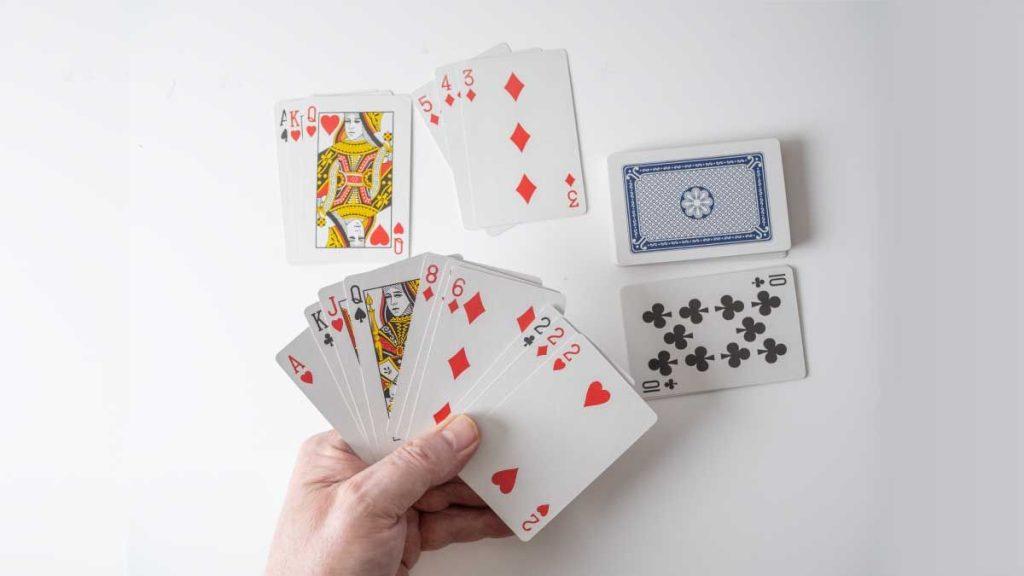Why Gin Rules is one of the most favourite Indian card games? How to play Gin rummy to win? Here provides you with a complete guide of Gin rummy rules and a full comparison with Indian rummy. So, let’s dive in!
What is Gin Rummy?
Gin Rummy is a two-player variant of Rummy games that was created in 1909, by Elwood T. Baker and his son C. Graham Baker. It is also called Gin, whose objective is to be the first to reach an agreed-upon score, usually 100 points.
Gin rummy is played using a standard deck of 52 cards. The ranking from high to low is King, Queen, Jack, 10, 9, 8, 7, 6, 5, 4, 3, 2, Ace.
In Gin rummy rules, at the beginning of the match, each player is dealt 10 cards. Any cards in your hand that are unmatched (not in melds) are called deadwood. Your primary goal is to have as little deadwood as possible.

What is the Difference between Gin Rummy and Indian rummy?
Similarities
- Both games are played with a standard 52-card deck, without the jokers.
- The goal of both games is to be the first player to score a certain number of points.
- In both games, players can score points by forming melds (sets and runs) and eliminating deadwood cards from their hands.
Differences
Here are some of the key differences between Rummy and Gin Rummy:
| Factors | Indian Rummy | Gin Rummy |
| Number of players | no specific number of players | 2 players only |
| Drawing cards | draw a card from the discard pile on their turn | choose to draw a card from the discard pile or the top of the deck. |
| Knocking | knock at any time | only knock if they have a hand that contains only melds and deadwood that totals 10 points or less |
| Going gin | no concept of going gin | go gin if players have a hand that contains only melds |
| Scoring | score points by winning melds | score points by knocking, going gin, or winning melds |
Gin Rummy Rules - Scoring Terms
In Gin Rummy rules, Scoring is the total calculation of deadwood and bonuses, the actual melds don’t actually count for anything, they’re only good to minimize your deadwood.
- Knock points: The number of knock points a player earns is equal to the number of deadwood points in their opponent’s hand. If the player who knocks has any deadwood points in their own hand, they receive a penalty of 10 points.
Player A: 5 5 5 (set), 7 8 9 (run), K K (set) = 0 deadwood points
Player B: 3 4 5 (run), 6 7 8 (run), A 2 3 (run) = 4 deadwood points
Player A knocks. Player B reveals their hand and has 4 deadwood points. Player A scores 4 knock points.
Explanation:
- Player A has no deadwood points, so they do not receive a penalty.
- Player B has 4 deadwood points, so Player A scores 4 knock points.
The final score is:
Player A: 4 knock points Player B: 0 points
Note that different variations of Gin Rummy may have different gin rummy rules of scoring. For example, in some variations of Gin Rummy, players cannot receive knock points if they have any deadwood points in their own hands.
2. Gin Bonus: If a player gets Gin he gets 25 extra points, added to the knock points he already got.
3. Big Gin Bonus: If a player gets Big Gin he gets 31 extra points, added to the knock points he already got.
4. Undercut: If the defending player has a deadwood count lower than or equal to that of the knocking player, they score an undercut bonus of 25 points plus the difference in deadwood in the knocking player’s hand.
5. Game bonus: Once a player has received 500 points (or some other agreed-upon number) the game is over, and that player obtains a game bonus of 100 points (or another agreed-upon number).
6. Line bonus or box bonus: At the end of the game, an extra 25 points for each hand won during the game is added.
7. Shutout bonus: If a game is finished with the winner having won every hand, the points for each hand are doubled before counting the line bonus.
Rummy Rules - How to Play Gin Rummy?
Here are some simple gin rummy rules that you should understand:
Setup
- Each player draws a card. The player with the lower card is the dealer.
- The dealer shuffles the deck and deals 10 cards to each player.
- The dealer turns over the top card of the remaining deck to start the discard pile.
Gameplay
On your turn, you must either:
- Pick up a card: You can pick up either the top card of the discard pile or the top card of the stockpile.
- Knock: If you have a hand that contains only melds (sets and runs) and deadwood (unmatched cards) that totals 10 points or less, you can knock.
- Go gin: If you have a hand that contains only melds, you can go gin.
To discard a card, place it face up on the discard pile.
Melds
A meld is a set or run of cards. A set is three or four cards of the same rank (e.g., 5-5-5 or 10-10-10-10). A run is three or more cards of the same suit in consecutive order (e.g., 3-4-5 of hearts or 7-8-9-10 of diamonds).
Deadwood
In gin rummy rules, Deadwood is any unmatched cards in your hand. Each deadwood card has a point value:
- Aces: 1 point
- 2-10: Face value (at their numerical values)
- Face cards (King, Queen, Jack): 10 points
Knocking
If you knock, the game ends, and you and your opponent reveal your hands. The player who knocked receives points for the deadwood in their opponent’s hand. If the player who knocked has any deadwood in their own hand, they receive a penalty of 10 points.
Going gin
Knock against your competitor in gin rummy rules as soon as you’ve matched all of your cards into runs and sets, which is otherwise known as “going gin.” When you go gin, you automatically get a bonus of 25 points, plus the sum of your competitor’s deadwood.
Scoring
In gin rummy rules, the first player to score 100 points wins the game. If a player scores 100 points on the same turn that they knock, they receive a bonus of 25 points.
How to Win Gin Rummy Online?
The most important to remember in gin rummy rules, you should knock when:
⚡You have almost all your cards in meld and
⚡The unmatched card in total is less than or equal to 10 points.
Best Tips and Strategy to Win Gin Rummy
⚡Don’t draw from the discards unless it completes a sequence.
⚡Keep a watchful eye on the discard pile.
⚡Pay attention to the middle card cause it offers better options.
⚡Hold onto high pairs early in the game.
⚡Get rid of higher-value cards rather than lower ones.
⚡Utilize card triangles to build melds.
⚡Extract the card you need from the opponent.
Join Deltin7 right now to get the best deals
As the leading Indian rummy platform, players can access up-to-date systems, the latest rummy games and tournaments and ongoing discounts and lucky bonuses.
Gin Rummy Rules - FAQs
More frequent questions and answers about gin rummy rules and rummy.
What is the Indian version of Rummy?
Indian rummy is inspired by the classic version of the rummy card game with 13 cards. The aim is to form groups of runs and sets to meet the rummy game rules. Jokers can be used to form the sequences or sets if at least one pure sequence is arranged.
Are there different versions of Rummy?
Like any other card game, there are several types of rummy. From Gin Rummy to Oklahoma Rummy to 500 Rummy, many variants are played across the globe. In India, the classic rummy or the 13 Card Rummy, also known as the ‘Indian Rummy,’ seems to be the most favoured.
Which is original in rummy?
The original rummy starts with 13-card rummy, which is a card game played with a standard 52-card deck, without the jokers. The goal of the game is to be the first player to form two sequences, including one pure sequence, and two sets.
Why rummy is not banned in India?
Rummy is considered a skill and strategy game in India, so playing rummy online for real cash is legal in almost all states of India. However, there are some places in India that haven’t recognized rummy or gin rummy legally to play for real cash.







